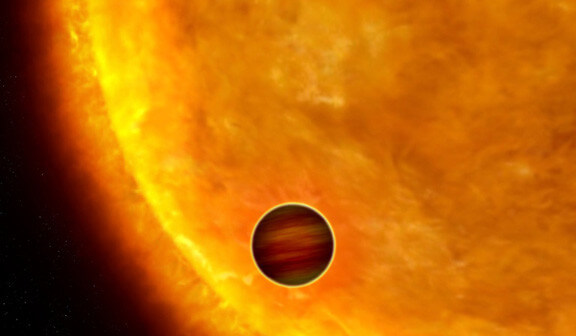 |
| The KELT-North telescope in Arizona. Courtesy Vanderbilt University. |
The Kilogree Extremely Little Telescope (KELT) comprises two telescopes — one in Arizona and one in South Africa — that each has a 4.2-centimeter opening. Altogether, KELT watches around 70% of the whole sky hunting down planets traveling brilliant hosts. Furthermore, it's as of later discovered a significant intriguing one: KELT-16b. In a publication led by Thomas Oberst (Westminster College in Pennsylvania), a group of researchers introduces their find.
KELT-16b is what's known as a hot Jupiter. Utilizing the KELT information and follow-up perceptions of 19 travels, Oberst and colleagues assess KELT-16b's sweep at about 1.4 circumstances that of Jupiter and its mass at 2.75 circumstances Jupiter's. Its balance temperature is a burning 2453 K — brought about by the way that it circles so near its host star that it finishes each circle in an unimportant 0.97 days!
This brief period is amazingly irregular: there are just five other known traveling exoplanets with periods shorter than a day. KELT-16b is circling near its host, making it subject to extraordinary light and solid tidal powers.
In light of KELT-16b's circle, Oberst and colleagues gauge that the planet started a runaway inspiral by the age of 1 billion years. Presently, at ~3.1 billion years of age, KELT-16b is circling at a sweep of a little more than 3 stellar radii over its host's surface. The creators appraise that KELT-16b's proceeding with internal winding could end in the planet's annihilation by tidal powers in as meager as an additional 550,000 years.
 |
| Artist’s impression of a transiting hot-Jupiter planet. The recently discovered KELT-16b orbits so close to its host that it zips around it in less than a day! NASA/ESA/G. Bacon (STScI) |
This exceptionally lighted world makes for a particularly valuable focus because of its brief period (which implies we can watch many travels) and brilliant host (which implies follow-up perceptions are more advantageous and have a vast flag-to-clamor proportion). Specifically, with follow-up perceptions of KELT-16b from missions like Hubble, Spitzer, and in the end the James Webb Space Telescope, we can take in more about open inquiries in exoplanet air forms — like how warmth is exchanged vertically through the air, or what occurs at the day-to-night eliminator line on such a profoundly lighted planet.
What's more, by studying KELT-16b, we can want to increase our general knowledge of hot Jupiter arrangement and movement. The simplicity of watching this planet and the abundance of data it can give will probably make it one of the top considered exoplanets. KELT-16b has a ton to show us before it's torn and separated!
Article Source: Thomas E. Oberst et al 2017 AJ 153 97. doi:10.3847/1538-3881/153/3/97

No comments:
Post a Comment